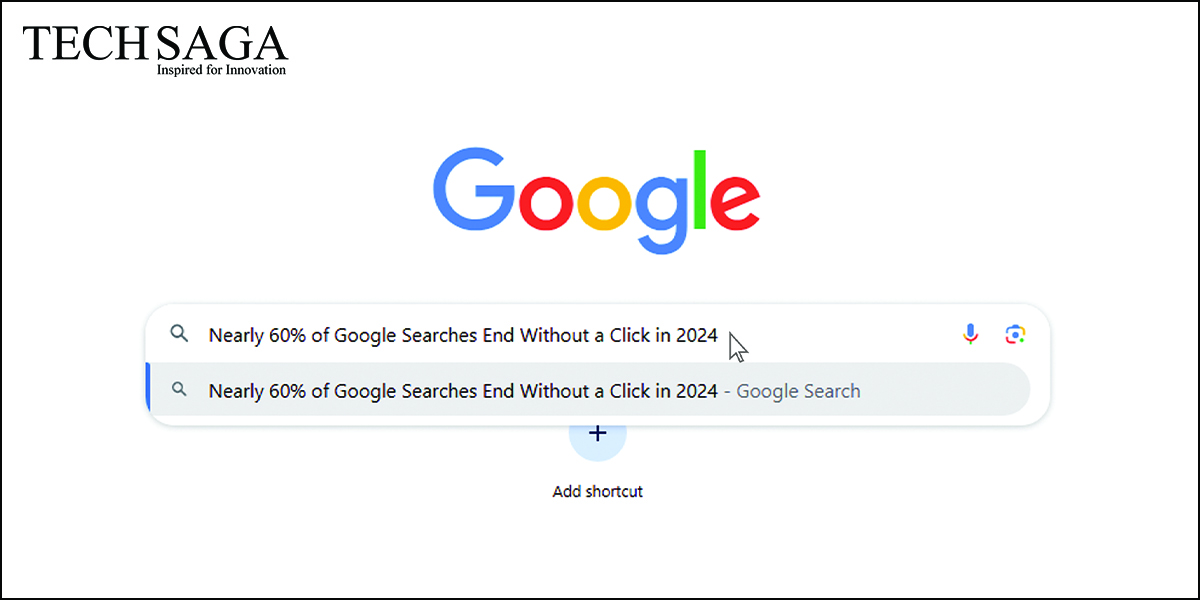Team Techsaga
Gain valuable insights and stay updated with the latest innovations through our engaging blog. Explore trends, technology advancements, and expert opinions to navigate the ever-evolving world of IT.
How Nearly 60% of Google Searches Ending Without a Click
A study has just disclosed a major variation in the users’ behavior of the Google Search tool. It turns out that almost 60% of all queries lead to a no-click exit, a growing phenomenon that highlights the shift of Google from searching to answering voice.
These changes are reflected in the statistics quoted from the United States and the European Union. In the United States, it is found that 58.5% of searches terminate without any further action, while in Europe, this figure is slightly higher at 59.7%. The latest searches combine six users who meet their needs via Google by snippets, maps, or quick facts—without any click away from the site.
The Rise of Zero-Click Searches
What Zero-Click Really Means
The term “zero-click search” refers to the case when a user submits a query but does not click any of the presented results. Instead, they receive the required information immediately—via a featured snippet, a calculator, a Knowledge Panel, or other Google-generated answers.
Though this may look favorable for the end-users, it is indicative of an important transition in the manner in which traffic is directed over the web. Google is progressively turning out to be the location where you get your information as well as the source of it.
Google’s Expanding Ecosystem
The research uncovered that almost one-third of all clicks still go to Google’s owned platforms, such as YouTube, Maps, and Images. Consequently, there is only a small percentage (around 36%) of clicks that lead to external websites, also called the open web.
This can be understood that if someone wants to find “best restaurants near me,” then he/she will never actually go to the restaurant’s website but use Google Maps for checking the reviews given by other people, find the location, and get some pictures – all this through the Google ecosystem.
Key Findings from the Study
The research, Datos released and Search Engine Land reported, took into account the analysis of user behaviour in the U.S. and EU from September 2022 to May 2023. Here are the key takeaways of the study.
-
Zero-Click Searches Dominate
The document supported the statement that the zero-click searches had become the majority. The fraction of Google search combinations in which no direct visits to websites happened was over 50%. What this indicates is SEO specialists’ turning point in which they have to calibrate the way they function, as the presence on the web does not always translate into traffic.
-
Traffic to Google-Owned Platforms Grows
About one-third of all user clicks are directed towards Google services, with examples like YouTube and Google Maps. For example, a person who is looking for “how to fix a leaking tap” can be referred to the YouTube tutorial; whereas a person who is searching for “coffee shops nearby” might directly interact with the Google Maps listing.
Such a trend reveals that Google is trying to understand how users use their services for a long time, rather than allowing them to go to other sites, which are not part of their ecosystem.
-
The Open Web Still Holds a Share
In spite of the decline, the open web still accounts for around 36% of search traffic in the U.S. and 37% in the EU. Given the billions of searches done every day, that is still a massive amount of traffic. Nevertheless, compared with previous years, the movement of Google-owned spaces is quite obvious.
-
AI Overviews Are Reshaping Search
In May 2024, Google unveiled the AI overviews, also referred to as the Search Engine Generative Experience (SGE). These are AI-generated summaries that offer complete solutions right at the search results page. As the excitement around this feature was at its peak, it got a strong critique for inaccuracies and was momentarily withdrawn to be fixed.
The research data shows that desktop searches were positively influenced post AI overviews, with a slight increase in user engagement. On the other hand, mobile users had a sharp decrease in engagement, pointing to the fact that they are still learning the new format.
-
Understanding the Data
Analysis by Datos was based on sizeable, authentic user panels drawn from several countries. The data set is extensive, but the researchers acknowledge that there is no perfect way of tracking. Yet, the trends strongly indicate Google’s rise as a direct source of information rather than a mere exit point for users.
What This Means for Businesses and SEO Professionals
Redefining “Traffic”
Clicks alone can no longer be the only yardstick of success for marketers and publishers. Being present on the search results page—via snippets, FAQs, and maps—has become equally important as visits to the landing page.
Adapting to Google’s World
The brands that want to retain their edge in the marketplace should plan to feature their profiles within Google’s space. The process involves optimizing for snippets, knowledge graphs, and visual results. Besides, the businesses can use YouTube content, Google Business Profiles, and local search tools to connect with the places where users are most active and thus remain visible.
Focusing on Intent and Experience
When Google provides the answer straight away, the brands should produce content that is more in-depth and comprehensive, providing background, the author’s qualification, or the reader’s experiences that cannot be found in a short paragraph or bullet point. This method promotes brand loyalty and creates opportunities for interactions that are beyond the search page.
Expanding Analytics Beyond Clicks
Thriving in this new search environment calls for the tracking of a broader range of performance metrics. It is now essential to keep an eye on the number of impressions, visibility of snippets, and engagement within Google’s ecosystem. These are the signs of how well your content matches user intent—even if it does not receive traditional clicks.
To Conclude
The 2024 zero-click research shows a big change in how people search online. Google isn’t just a way to get to the internet anymore—it’s the place where people go.
Users get quicker responses and an easier flow. Marketers and content creators have to transform their tactics in order to witness their presence in the places where users decide, i.e.,. Inside Google’s results.
While AI-driven search is getting better, the main thing that remains is knowledge of users’ search habits, what they look at, and how they decide in Google’s world, this will be the future of visibility online.




